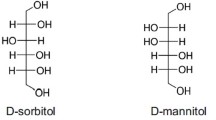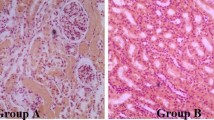Summary
Dogs in which the area postrema was destroyed electrolytically have been compared to normal dogs and dogs with various control operations with respect to (1) sodium and potassium excretion and serum levels of these ions on a normal salt diet; (2) their response to salt deprivation; (3) their response to water loading and water deprivation; and (4) their response to hypertonic salt loading in the unanesthetized and the anesthetized state.
No chronic abnormalities of electrolyte metabolism were present in the dogs with lesions of the area postrema. They also excreted a water load and concentrated their urine in response to dehydration in a normal fashion. However, they did not respond to salt loading with the acute rise in sodium secretion seen in normal dogs. This defect appears to be due in part at least to a failure to decrease tubular reabsorbation of sodium to a great degree as the normal animals. The implications of these findings are discussed.
Zusammenfassung
Hunde mit elektrolytisch zerstörter Area postrema wurden mit normalen Hunden und solchen mit verschiedenen Kontrolloperationen in folgender Hinsicht verglichen: 1. Natrium und Kaliumexkretion und Serumspiegel dieser Ionen bei normaler Salzdiät, 2. Reaktion auf Salzmangel, 3. Reaktion auf Wasserbelastung und auf Durst, 4. Reaktion auf Belastung mit hypertoner Salzlösung in nicht anästhesiertem und anästhesiertem Zustand.
Bei den Hunden mit Läsionen der Area postrema trat kein dauernder abnormaler Elektrolytenstoffwechsel auf. Die Tiere zeigten auch bei Wasserbelastung eine Exkretion und konzentrierten ihren Harn bei Dehydrierung in normaler Weise. Sie antworteten jedoch nicht auf eine Belastung mit dem akuten Ansteigen der Natriumausscheidung, die bei normalen Hunden beobachtet wird. Dieser Defekt scheint zumindest teilweise dadurch bedingt, daß die Fähigkeit zur Verminderung der tubulären Rückresorption von Natrium entgegen den normalen Tieren, bei denen sie in hohem Maße vorhanden ist, fehlt. Die Folgerungen dieser Befunde werden diskutiert.
Résumé
Des chiens avec destruction électrolytique de l'area postrema furent comparés à des chiens normaux et ceux avec des opérations contrôles variées: 1. Sodium- et potassium-excrétion et valeur de sérum de ces ions sous diète saline normale, 2. réaction sous déchloruration, 3. réponse à surcharge hydrique et à soif, 4. réaction après surcharge de solution chlorurée hypertone en état anaesthétique et non anaesthétique.
Chez des chiens avec lésion de l'area postrema aucun métabolisme électrolytique durable se manifesta. Les animaux montrèrent aussi une excrétion sous surcharge hydrique et une concentration urinaire normale sous déshydratation. Mais ils ne montrèrent aucune augmentation aiguë de l'excrétion de sodium après surcharge, laquelle est observée chez des chiens normaux. Ces défets sont peut-être — au moins partiellement — causés par le manque pour diminuer la résorption tubulaire de sodium comparée à sa hauteur trouvée chez des chiens normaux. Les conséquences de ces résultats sont discutées.
Similar content being viewed by others
References
Ayres, P. J., O. Ganod, S. A. S. Tait, J. F. Tait, G. Walker andW. H. Pearlman, The use of (16-H) aldosterone in studies on human peripheral blood. Ciba Colloq. on Endocrinol.11 (1957), 309–327.
Bernard, C., cited byCushny, A. R., Secretion of urine. Ed. 2, p. 15 and 135–137, Longmans, Green, 1926.
Berne, R. M., Hemodynamics and sodium excretion of the denervated kidney in anesthetized and unanesthetized dogs. Amer. J. Physiol.171 (1952), 148–152.
Clemente, C. D., J. Sutin andJ. T. Silverstone, Changes in electrical activity of the medulla on the intravenous injection of hypertonic solutions. Amer. J. Physiol.188 (1957), 193–198.
Cort, J. H., Cerebral salt wasting. Lancet1 (1954), 752–753.
Daily, W. J. R., andW. F. Ganong, The effect of ventral hypothalamic lesions on sodium and potassium metabolism in the dog. Endocrinology62 (1958), 442–454.
Ganong, W. F., andP. J. Mulrow, The rate of change in sodium and potassium excretion after injection of aldosterone into the aorta and renal artery of the dog. Amer. J. Physiol.195 (1958), 337–342.
Kaplan, S. A., andS. Rapoport, Urinary excretion of sodium and chloride after sphlanchnicotomy: effect on the proximal tubule. Amer. J. Physiol.164 (1951), 175–178.
Kaplan, S. A., C. D. West andS. J. Fomon, Effects of unilateral division of the sphlanchnic nerve on the renal excretion of electrolytes in unanesthetized and anesthetized dogs: the mechanism of “crossed stimulation”. Amer. J. Physiol.175 (1953), 363–372.
Page, L. B., C. F. Baxter, G. H. Reem, J. C. Scott-Baker andH. W. Smith, Effect of unilateral sphlanchinic nerve resection on the renal excretion of sodium. Amer. J. Physiol.177 (1954), 194–201.
Peters, J. P., L. G. Welt, E. A. H. Sims, J. Orloff andJ. Needham, A saltwasting syndrome associated with cerebral disease. Trans. Ass. Amer. Physicians63 (1950), 57–63.
Phillips, R. A., Creatinine in plasma and apparent “creatinine” in old blood. I. Quantitative Clinical Chemistry. Vol. 2, pp. 604–605. Peters J. P., and D. D. Van Slyke, Williams and Wilkins, Baltimore, 1946.
Smith, H. W., Principles of renal physiology. Pp. 163–179, Oxford University Press, New York, 1956.
Smith, H. W., Salt and Water volume receptors. Amer. J. Med.23 (1957), 623 to 652.
Surtshin, A., andJ. Hoeltzenbein, Excretion of sodium and water by the denervated canine kidney. Amer. J. Physiol.177 (1954), 44–53.
Author information
Authors and Affiliations
Additional information
With 5 Figures
Supported by grants from the Commonwealth Fund and from the Christine Breon Fund for Medical Research, made available by the Committee on Research of the School of Medicine, University of California.
Rights and permissions
About this article
Cite this article
Wise, B.L., Ganong, W.F. The effect of ablation of the area postrema on water and electrolyte metabolism in dogs. Acta Neurovegetativa 22, 14–32 (1960). https://doi.org/10.1007/BF01226650
Issue Date:
DOI: https://doi.org/10.1007/BF01226650




